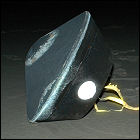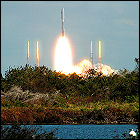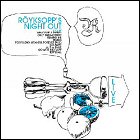 Sci-Fi Channel airs the 31st episode of Stargate Atlantis. Mitch Pileggi (The X-Files) guest stars.
Sci-Fi Channel airs the 31st episode of Stargate Atlantis. Mitch Pileggi (The X-Files) guest stars. ![]()

Earl Green is the creator, curator, and head writer of theLogBook.com.
 Sci-Fi Channel airs the 31st episode of Stargate Atlantis. Mitch Pileggi (The X-Files) guest stars.
Sci-Fi Channel airs the 31st episode of Stargate Atlantis. Mitch Pileggi (The X-Files) guest stars. ![]()
 Sci-Fi channel airs the 24th episode of Ronald D. Moore’s re-imagining of Battlestar Galactica. Michelle Forbes guest stars.
Sci-Fi channel airs the 24th episode of Ronald D. Moore’s re-imagining of Battlestar Galactica. Michelle Forbes guest stars. ![]()
 ABC airs the 34th episode of the J.J. Abrams-produced series Lost.
ABC airs the 34th episode of the J.J. Abrams-produced series Lost. ![]()
 ABC premieres the 11th episode of Shaun Cassidy’s sci-fi/horror series Invasion, starring William Fichtner (Contact), Eddie Cibrian, and Lisa Sheridan.
ABC premieres the 11th episode of Shaun Cassidy’s sci-fi/horror series Invasion, starring William Fichtner (Contact), Eddie Cibrian, and Lisa Sheridan. ![]()
 The first episode of the science fiction sitcom Hyperdrive premieres on BBC2, starring Nick Frost, Miranda Hart and Kevin Eldon.
The first episode of the science fiction sitcom Hyperdrive premieres on BBC2, starring Nick Frost, Miranda Hart and Kevin Eldon. ![]()
![]()
 The 185th episode of Stargate SG-1 airs on the Sci-Fi Channel, starring Ben Browder, Amanda Tapping, Christopher Judge, Beau Bridges, and Michael Shanks.
The 185th episode of Stargate SG-1 airs on the Sci-Fi Channel, starring Ben Browder, Amanda Tapping, Christopher Judge, Beau Bridges, and Michael Shanks. ![]()
 Sci-Fi Channel airs the 32nd episode of Stargate Atlantis.
Sci-Fi Channel airs the 32nd episode of Stargate Atlantis. ![]()
 Sci-Fi channel airs the 25th episode of Ronald D. Moore’s re-imagining of Battlestar Galactica. Michelle Forbes guest stars.
Sci-Fi channel airs the 25th episode of Ronald D. Moore’s re-imagining of Battlestar Galactica. Michelle Forbes guest stars. ![]()
 NASA’s unmanned Stardust space probe successfully returns its samples of comet and interstellar dust to Earth. A few minutes after 5:00am Eastern time, the Stardust sample return capsule makes a soft landing in Utah, its record-setting 29,000mph return to Earth slowed by a series of parachutes. (Before Stardust’s return, the fastest vehicle to enter Earth’s atmosphere was the capsule bringing home the crew of Apollo 10 in May 1969.) It is hoped that analysis of the tiny particles captured in cakes of a special porous material called aerogel will shed some light on the origins of the solar system. The “mother ship” portion of the Stardust probe is left on a course that will put it into a permanent orbit around the sun. Stardust was launched in February 1999, and gathered its samples from the cloud of gas and dust surrounding Comet Wild-2 in January 2004, zipping through the comet’s coma at 13,000mph.
NASA’s unmanned Stardust space probe successfully returns its samples of comet and interstellar dust to Earth. A few minutes after 5:00am Eastern time, the Stardust sample return capsule makes a soft landing in Utah, its record-setting 29,000mph return to Earth slowed by a series of parachutes. (Before Stardust’s return, the fastest vehicle to enter Earth’s atmosphere was the capsule bringing home the crew of Apollo 10 in May 1969.) It is hoped that analysis of the tiny particles captured in cakes of a special porous material called aerogel will shed some light on the origins of the solar system. The “mother ship” portion of the Stardust probe is left on a course that will put it into a permanent orbit around the sun. Stardust was launched in February 1999, and gathered its samples from the cloud of gas and dust surrounding Comet Wild-2 in January 2004, zipping through the comet’s coma at 13,000mph.
 ABC airs the 35th episode of the J.J. Abrams-produced series Lost. M.C. Gainey guest stars.
ABC airs the 35th episode of the J.J. Abrams-produced series Lost. M.C. Gainey guest stars. ![]()
 ABC premieres the 12th episode of Shaun Cassidy’s sci-fi/horror series Invasion, starring William Fichtner (Contact), Eddie Cibrian, and Lisa Sheridan. Elizabeth Moss (The Handmaid’s Tale) guest stars.
ABC premieres the 12th episode of Shaun Cassidy’s sci-fi/horror series Invasion, starring William Fichtner (Contact), Eddie Cibrian, and Lisa Sheridan. Elizabeth Moss (The Handmaid’s Tale) guest stars. ![]()
 The second episode of the science fiction sitcom Hyperdrive premieres on BBC2, starring Nick Frost, Miranda Hart and Kevin Eldon. Geoffrey McGivern (The Hitchhiker’s Guide To The Galaxy) and Montserrat Lombard (Ashes To Ashes) guest star.
The second episode of the science fiction sitcom Hyperdrive premieres on BBC2, starring Nick Frost, Miranda Hart and Kevin Eldon. Geoffrey McGivern (The Hitchhiker’s Guide To The Galaxy) and Montserrat Lombard (Ashes To Ashes) guest star. ![]()
 NASA launches the unmanned New Horizons probe on a course for the minor planet Pluto, the first spacecraft built to explore that destination. A trajectory with multiple planetary flybys and gravitational assists is designed to sling New Horizons toward Pluto within a decade (compared to Voyager 2’s 12-year trek to Neptune).
NASA launches the unmanned New Horizons probe on a course for the minor planet Pluto, the first spacecraft built to explore that destination. A trajectory with multiple planetary flybys and gravitational assists is designed to sling New Horizons toward Pluto within a decade (compared to Voyager 2’s 12-year trek to Neptune).
New Horizons will enter Pluto’s surprisingly complex system in 2015.
 ITV premieres the first episode of Steven Gallagher’s short-lived science fiction drama Eleventh Hour, starring Patrick Stewart (Star Trek: The Next Generation).
ITV premieres the first episode of Steven Gallagher’s short-lived science fiction drama Eleventh Hour, starring Patrick Stewart (Star Trek: The Next Generation). ![]()
 The 186th episode of Stargate SG-1 airs on the Sci-Fi Channel, starring Ben Browder, Amanda Tapping, Christopher Judge, Beau Bridges, and Michael Shanks.
The 186th episode of Stargate SG-1 airs on the Sci-Fi Channel, starring Ben Browder, Amanda Tapping, Christopher Judge, Beau Bridges, and Michael Shanks. ![]()
 Sci-Fi Channel airs the 33rd episode of Stargate Atlantis. Beau Bridges and Mitch Pileggi (The X-Files) guest star.
Sci-Fi Channel airs the 33rd episode of Stargate Atlantis. Beau Bridges and Mitch Pileggi (The X-Files) guest star. ![]()
 Sci-Fi channel airs the 26th episode of Ronald D. Moore’s re-imagining of Battlestar Galactica. Colm Feore guest stars.
Sci-Fi channel airs the 26th episode of Ronald D. Moore’s re-imagining of Battlestar Galactica. Colm Feore guest stars. ![]()
 Wanna-be fifth networks UPN and the WB both announce that they will go off the air in late 2006, after 11 years of struggling to make a dent against the “big four” networks. (Both networks signed on in January 1995, the WB premiering its programming one week before UPN went on the air with the premiere of Star Trek: Voyager; WB later found its own genre niche with the series adaptation of Joss Whedon’s Buffy: The Vampire Slayer and its popular spinoff, Angel, along with the “young Superman” prequel Smallville.) However, some of their programming may survive to be seen on a new joint venture between Warner Bros. and UPN’s parent network, CBS. This new network, The CW, will have programming and personnel held over from both defunct networks. The announcements do not mention how the merger will work out in broadcast markets where affiliate stations exist for both networks.
Wanna-be fifth networks UPN and the WB both announce that they will go off the air in late 2006, after 11 years of struggling to make a dent against the “big four” networks. (Both networks signed on in January 1995, the WB premiering its programming one week before UPN went on the air with the premiere of Star Trek: Voyager; WB later found its own genre niche with the series adaptation of Joss Whedon’s Buffy: The Vampire Slayer and its popular spinoff, Angel, along with the “young Superman” prequel Smallville.) However, some of their programming may survive to be seen on a new joint venture between Warner Bros. and UPN’s parent network, CBS. This new network, The CW, will have programming and personnel held over from both defunct networks. The announcements do not mention how the merger will work out in broadcast markets where affiliate stations exist for both networks.
 ABC airs the 36th episode of the J.J. Abrams-produced series Lost. Neil Hopkins guest stars.
ABC airs the 36th episode of the J.J. Abrams-produced series Lost. Neil Hopkins guest stars. ![]()
 ABC premieres the 13th episode of Shaun Cassidy’s sci-fi/horror series Invasion, starring William Fichtner (Contact), Eddie Cibrian, and Lisa Sheridan.
ABC premieres the 13th episode of Shaun Cassidy’s sci-fi/horror series Invasion, starring William Fichtner (Contact), Eddie Cibrian, and Lisa Sheridan. ![]()
 The third episode of the science fiction sitcom Hyperdrive premieres on BBC2, starring Nick Frost, Miranda Hart and Kevin Eldon.
The third episode of the science fiction sitcom Hyperdrive premieres on BBC2, starring Nick Frost, Miranda Hart and Kevin Eldon. ![]()
 ITV premieres the second episode of Steven Gallagher’s short-lived science fiction drama Eleventh Hour, starring Patrick Stewart (Star Trek: The Next Generation).
ITV premieres the second episode of Steven Gallagher’s short-lived science fiction drama Eleventh Hour, starring Patrick Stewart (Star Trek: The Next Generation). ![]()
 The 187th episode of Stargate SG-1 airs on the Sci-Fi Channel, starring Ben Browder, Amanda Tapping, Christopher Judge, Beau Bridges, and Michael Shanks.
The 187th episode of Stargate SG-1 airs on the Sci-Fi Channel, starring Ben Browder, Amanda Tapping, Christopher Judge, Beau Bridges, and Michael Shanks. ![]()
 Sci-Fi Channel airs the 34th episode of Stargate Atlantis. Amanda Tapping (Stargate SG-1) guest stars.
Sci-Fi Channel airs the 34th episode of Stargate Atlantis. Amanda Tapping (Stargate SG-1) guest stars. ![]()
 Sci-Fi channel airs the 27th episode of Ronald D. Moore’s re-imagining of Battlestar Galactica. Richard Hatch guest stars.
Sci-Fi channel airs the 27th episode of Ronald D. Moore’s re-imagining of Battlestar Galactica. Richard Hatch guest stars. ![]()
 Astralwerks releases the Röyksopp live album Röyksopp’s Night Out.
Astralwerks releases the Röyksopp live album Röyksopp’s Night Out. ![]()
 Big Finish Productions releases the 78th Doctor Who audio drama in its main monthly range, starring Colin Baker and Maggie Stables.
Big Finish Productions releases the 78th Doctor Who audio drama in its main monthly range, starring Colin Baker and Maggie Stables. ![]()
 The fourth episode of the science fiction sitcom Hyperdrive premieres on BBC2, starring Nick Frost, Miranda Hart and Kevin Eldon. Colin McFarlane (Torchwood, Batman Begins, The Dark Knight) guest stars.
The fourth episode of the science fiction sitcom Hyperdrive premieres on BBC2, starring Nick Frost, Miranda Hart and Kevin Eldon. Colin McFarlane (Torchwood, Batman Begins, The Dark Knight) guest stars. ![]()
 ITV premieres the third episode of Steven Gallagher’s short-lived science fiction drama Eleventh Hour, starring Patrick Stewart (Star Trek: The Next Generation).
ITV premieres the third episode of Steven Gallagher’s short-lived science fiction drama Eleventh Hour, starring Patrick Stewart (Star Trek: The Next Generation). ![]()
 The 188th episode of Stargate SG-1 airs on the Sci-Fi Channel, starring Ben Browder, Amanda Tapping, Christopher Judge, Beau Bridges, and Michael Shanks.
The 188th episode of Stargate SG-1 airs on the Sci-Fi Channel, starring Ben Browder, Amanda Tapping, Christopher Judge, Beau Bridges, and Michael Shanks. ![]()